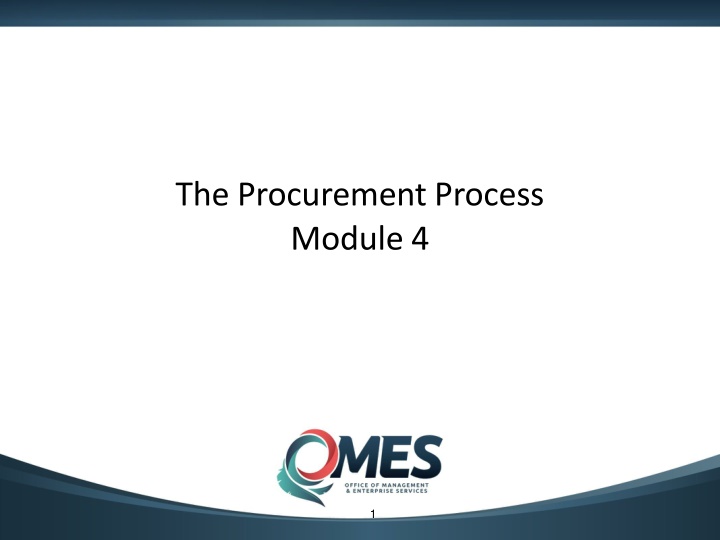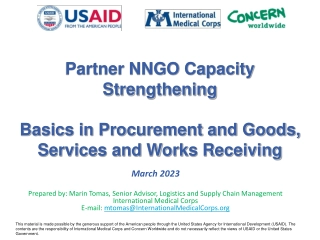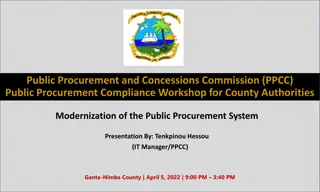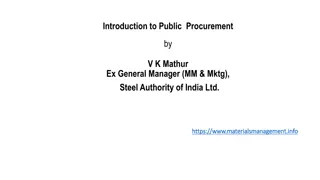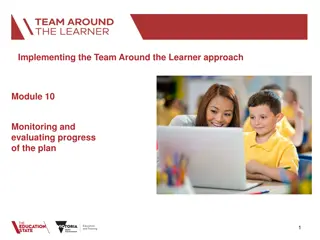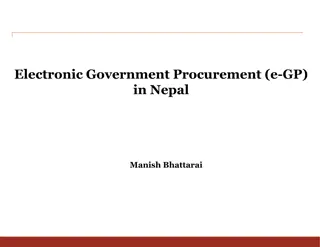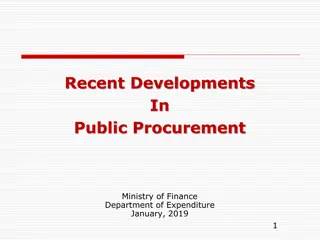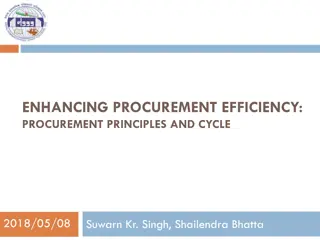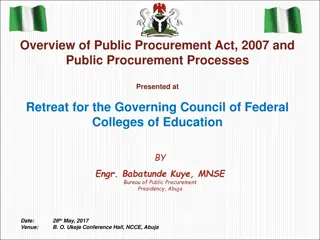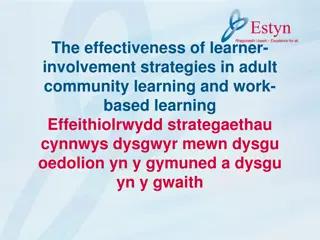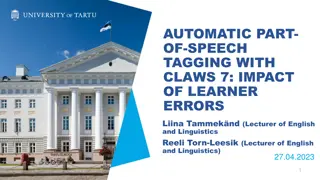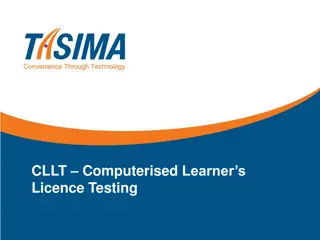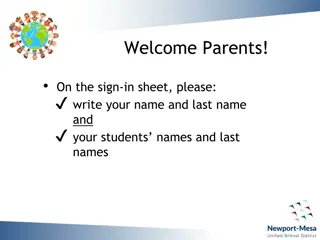The Procurement Process Module 4 Learner Outcomes and Stages Overview
In this module, learners will understand the stages in the procurement process, appropriate bid methods, solicitation initiation, state agency acquisitions, and more. The focus is on enhancing knowledge of procurement practices and regulations.
Download Presentation

Please find below an Image/Link to download the presentation.
The content on the website is provided AS IS for your information and personal use only. It may not be sold, licensed, or shared on other websites without obtaining consent from the author.If you encounter any issues during the download, it is possible that the publisher has removed the file from their server.
You are allowed to download the files provided on this website for personal or commercial use, subject to the condition that they are used lawfully. All files are the property of their respective owners.
The content on the website is provided AS IS for your information and personal use only. It may not be sold, licensed, or shared on other websites without obtaining consent from the author.
E N D
Presentation Transcript
The Procurement Process Module 4 1
Learner Outcomes Students will: Recite the stages in the procurement process. Recall the most appropriate bid method for small purchases. Memorize when the procurement process begins. Recall the most complex method to evaluate offers. Name the type of solicitation most appropriate for informal solicitation (less than $10,000) purchases. 2
Learner Outcomes Students will: Recall how a state agency acquisition processed by Central Printing must be initiated. Recall the state purchasing director s authority to perfect an administrative error by the state agency or unforeseeable circumstances. Identify which commission authorizes lease-purchase agreements for real property or equipment. 3
Learner Outcomes Students will: Recall what certificate the state purchasing director includes with any bid or proposal submitted to the agency issuing the solicitation. Recognize what threshold that state agencies shall make acquisitions provided the acquisition process is fair and reasonable. Identify where Public Finance is found in the Oklahoma State Statutes. Recall how many quotes are required for agency acquisitions greater than $5,000.01 and less than $10K. 4
The ProcurementProcess The procurement process always begins when the need is identified. After the need is identified, the process may vary depending upon the solicitation process you use. We ll take a brief look at the procurement process now, and a closer look when we study solicitation development. 5
The ProcurementProcess Stage 1: NeedIdentification Identify the need for the acquisition and when it is needed. Identify the delegated authority of your entity to make the acquisition and whether it is within the strategic mission of your entity. Identify the source and availability of funding for the acquisition. Determine if product or service is available through State Use or Oklahoma Correctional Industries. Determine whether the item is exempt under the Central Purchasing Act. Determine whether the item can be obtained through an existing source (such as Property Reutilization) or contract. Determine whether special approvals/restrictions apply. 6
The ProcurementProcess Stage 2: Solicitation Preparation Identify the most appropriate purchasing method to be used (i.e., Request for Proposal, Invitation to Bid). The method you use will determine which steps you will want to take in the process. Identify scope, stakeholders, evaluation team and minimum critical business requirements. Your solicitation team and your evaluation team should be determined prior to beginning the needsanalysis. Conduct market analysis to identify available goods, services and bidders. Address any marketconstraints. Plan the solicitation. 7
The ProcurementProcess Stage 2: Solicitation Preparation Select appropriate solicitation template. Construct solicitation and evaluation documents. Select contract templates (if needed). Submit any required documents for outside prior approval (i.e., Attorney General s approvals for attorneys, Chief Information Officer Systems Planning for IT acquisitions, treasurer s approval on financial institutions). 8
The ProcurementProcess Stage 3: Bidding Process State Actions: Publicly advertise solicitations. Conduct pre-bids or bidder education when needed. Conduct end user education when needed. Manage communications. Clarify questions, conduct interviews as needed, ensure all bidders receive the same information. Amend or cancel solicitations as needed. Receive bidder responses and close the solicitation. 9
The ProcurementProcess Stage 3: Bidding Process Bidder Actions: Access and review solicitations. Ask for clarification as needed. Prepare and submit the response. Revise or withdraw the response. 10
The ProcurementProcess Stage 4: Evaluation Process State Actions: Manage the evaluation process. Verify bidders eligibility for contract award. Solicit additional information from bidders as needed (may include conducting interviews or demonstrations). Conduct negotiations if appropriate. Finalize contract discussions. 11
The ProcurementProcess Stage 4: Evaluation Process Bidder Actions: Respond to requests for clarifications, if any. Appear at interviews, if any. Participate in negotiations, if any. Participate in contract discussions, if any. 12
The ProcurementProcess Stage 5: Award Process State Actions for a Request for Proposal or Invitation to Bid: Provide public notice of solicitation results. Check to be sure bidder has met all the registration, financial and insurance requirements. Have all solicitation records available for prompt review by bidders. Issue contract award. Participate in protest process if applicable. 13
The ProcurementProcess Stage 5: Award Process Request for Proposal or Invitation to Bid Supplier Actions: Receive contract award as applicable. Contact user agency for Notice to Proceed. Participate in protest process if applicable. 14
The ProcurementProcess Stage 6: Contract Process State Actions: Administer and manage the contract and discuss any new risks or changes in either the schedule or pricing. Work with supplier to resolve any contract disputes. Complete contract close out tasks. Evaluate supplier/product performance. 15
The ProcurementProcess Stage 6: Contract Process Supplier Actions: Perform under the contract requirements. File any required reports and discuss with the state any changes to the timeline or pricing. Work with state entity to resolve any contract disputes. Deliver any as builts, diagrams, reference materials and warranties to state agency for future needs. 16
The ProcurementProcess NOTE Invoicing and ratification are considered part of the payment or ratification process. Complete and accurate documentation during the procurement process has a direct impact on the invoicing and ratification/payment process. If a requisition is not correctly created and maintained in PeopleSoft, receipting and invoicing will be problematic and payment will potentially be delayed. 17
Why We Need Procurement Guidelines Acquiring services and commodities requires skills, discipline and knowledge. The fundamental mission of the centralized procurement function is to provide the state with the goods and services it needs. Successful suppliers must provide quality goods and services at reasonable lowest and best costs or best value. 18
Why We Need Procurement Guidelines Knowledge of the Central Purchasing Act and Rules establishes a level playing field and protects the buyer. A state agency shall retain acquisition records to include, but not limited to, justification for the acquisition, supporting documents, related information, acquisition contract, evaluations, other evidence of contractor performance and written reports. 19
Price Analysis Price analysis is the examination of a vendor's price. What is the most appropriate evaluation method for simple purchases? Price Analysis!! 20
Value Analysis Value analysis in purchasing is to allow purchasers to improve the value obtained from purchases. What is the most complex method to evaluate offers? Value Analysis! 21
Lowest and Best Lowest and Best means an acquisition based on criteria which include, but are not limited to: The lowest total purchase price. The quality and reliability of the product. The consistency of the proposed acquisition with the state agency s planning documents and announced strategic program direction. 22
Lowest and Best Defined in Title 74, section 85.2.19. based on criteria which include but not limited to and gives a list of items you might use for Lowest and Best criteria. Lowest price that meets specifications. Lowest and Best is used in Invitations to Bid. 23
Best Value Best Value means evaluation criteria which include, but are not limited to: The acquisition s operational cost a state agency would incur. The quality of the acquisition, or its technical competency. The reliability of the bidder s delivery and implementation schedules. The acquisition s facilitation of data transfer and systems integration. 24
Best Value Continued Best Value means evaluation criteria which include, but are not limited to: The acquisition s warranties and guarantees and the bidder s return policy. The bidder s financial stability. The acquisition s adherence to the state agency s planning documents and announced strategic program direction. 25
Best Value -Continued Best Value means evaluation criteria which include, but are not limited to: The bidders industry and program experience and record of successful past performance with acquisitions of similar scope and complexity. The anticipated acceptance by user groups. The acquisition s use of proven development methodology and innovative use of current technologies that lead to quality results. The agency s desire to negotiate the award. 26
BestValue Defined in Title 74, section 85.2.2. Evaluation criteria which include, but is not limited to gives 10 ideas for criteria. The term may adds increased flexibility. Best Value is the method used in Requests for Proposals. Weighted evaluation criteria prior to posting provides basis for contract award. Criteria (less weighting) must be included in the RFP. 27
Common Procurement Practices Request for Information. Request for Quotation. Request for Proposal. Invitation to Bid. 28
Request for Information: Use: Surveying the marketplace to assist with future specification development. No pricing isrequested. No contract is awarded. Agencies are not required to send RFI s. 29
Request for Quotation (RFQ) Use: Method of Award: Low dollar and low risk. May be written or verbal (telephone or mail quotes). Lowest andbest. Or best value. 30
Request for Quotation The type of solicitation most appropriate for informal solicitation (less than $10,000) purchases is a Request for Quotation. Bidder submits an itemized listing of items/services and their costs. Items should be Freight On Board destination and delivery dates should be included. Must be received via telephone, letter or electronic (email or fax). Three or ten registered bidders depending on estimated costs. Tax should not be included in the quote. 31
Request for Proposal Uses: Method of Award: Specifications not clearlydefined. Several possible solutions may meet agency needs. Cost is only one factor in determiningaward. Negotiations may be beneficial. Best offer (best value). Point based evaluation (determined before RFP is posted). 32
Request for Proposal Negotiations may be on price, timelines, selection from products offered and terms and conditions. Not all terms and conditions can be negotiated. Terms which have a statutory origin cannot be negotiated. 33
Invitation to Bid Use: Solicitations where requirements are well defined and detailed for goods and/or services. Formal process. Written documents. Public openings. Negotiations can be done. Method of Award: Lowest and Best 34
Procurement Decision Points What to buy and how much itcosts. How to buy. Obtaining estimates/quotations. Checking your budget. Selecting a vendor. Receipt and verification. Payments to suppliers. 35
What to Buy What would you like to purchase? Commodity: A tangible product or good. Service: An intangible function provided, such as providing maintenance or repair. 36
How Complex is it? Once you have determined the acquisition is not available from and exempt source, the complexity of the acquisition determines the (informal or formal) procurement method. Exempt sources will be discussed in future lessons. 37
How Much Does it Cost? Cost Thresholds: Purchases for $0-$5,000. Purchases for $5,000.0-$10,000. Purchases for $10,000.01-$25,000. Purchases for $25,000.01-$50,000. Purchases for $50,000.01-$100,000. Purchases for $100,001 +. 38
How Much Does itCost? Use a P-card for: Single Transactions Within agency restrictions up to $5,000. Utility bill of any amount. Interagency purchases. Title 18 professional services. Statewide contract for any amount. Travel with restrictions. Follow P-card Procedures Use of the P-card does not relieve you from using the from using mandatory sources. 39
Total, Non-Repetitive Purchase Less than $5,000 If the item/service is not available from an exempt or mandatory source: State agencies shall make acquisitions not exceeding $5,000.00, provided the acquisition process is fair and reasonable and is conducted pursuant to rules authorized pursuant to this section. To assure you can document that your purchase was fair and reasonable, two quotes are preferred. Procurement file should document how you knew the price was fair and reasonable, the justification for the purchase and the delivery date and terms. Use P-card for supplies, services, memberships, dues, online orders and periodicals/subscriptions. Use Purchase Order or other pre-encumbrance document. 40
Total Purchase Greater than $5,000 and Less than $25,000 If the item or service is not available from an exempt source: Solicit three quotes for from registered bidders for purchases from $5,000.01 to $10,000. Solicit 10 quotes or formal bids from registered bidders for purchases from $10,000.01 to $25,000. Purchase item or service from bidder offering the lowest and best or best value. Attach quotes to purchase documentation and maintain as part of agency records (for auditing purposes). New Law Effective 11-1-2015, from House Bill 1353: Gives a three-point preference to businesses that are majority owned by Disabled Veterans and allows the Director of the Office of Management and Enterprise Services to write rules pursuant to the act. 41
Total Purchase Greater than $5,000 and Less than $25,000 (cont.) If an item is not available from an exemptsource: The agency may conduct the solicitation using a formal or informal process depending on the complexity of the acquisition. Regardless of the method of acquisition, the state agency shall make a written evaluation of criteria considered in selection of the supplier for the acquisition. Documentation of prices, delivery dates and the evaluation shall be placed in the acquisition file. If you are using lowest and best , you still must document why the product was best in the acquisition file. 42
Total Purchase Greater than $5,000 and Less than $25,000 (cont.) All awards shall be based on lowest and best or best value criteria. Certifications, verifications and other required documents: The state purchasing director shall include a non-collusion certificate in a solicitation which shall be included with any bid or proposal submitted to the agency issuing the solicitation. Sales tax permit verification, vendor registration and Secretary of State registration. Certification for professional service contract if applicable. Verification of vendor not being debarred by the federal government and reciprocal laws have been followed. 43
Total Purchase Greater than $5,000 and Less than $25,000 (cont.) Bonds and sureties. The solicitation may require bidders to submit a bid bond, performance bond or other type of approved surety with the bid. Form of bond. The bid bond, performance bond or other type of surety shall be subject to the approval of the state purchasing director. For bonds requiring a cash deposit, the amount specified by the state purchasing director shall be paid by certified check or cashiers check. 44
Total Purchase Greater than $5,000 and Less than$25,000 (cont.) Irrevocable letter of credit. In lieu of bonds specified in this subsection, the state purchasing director may approve submission of an irrevocable letter of credit. Bond or surety return. When the state purchasing director specifies a bid contain a bid bond, performance bond or other type of surety, the state purchasing director shall retain the bond or surety until the successful completion of the purpose for which the bond or surety was drawn. 45
Total Purchases Greater than $25,000 and Less than $50,000 If an item is not available from an exemptsource: State agencies shall solicit prices and delivery dates by means of sealed bid from all registered bidders using mail or electronic commerce. The bidders shall provide pricing and delivery dates in accordance with the requirements of the solicitation. The state agency shall make a written evaluation of pre-determined criteria considered in selection of the supplier for the acquisition. The written evaluation shall be placed in the acquisition file. When a selection has been made, the state agency shall notify the supplier of the award. All awards shall be based on lowest and best or best value criteria. 46
Total Purchases Greater than $25,000 and Less than $50,000 (cont.) Certifications, verifications and other required documents: Non-collusion certification. Vendor registration is current. Sales tax permit verification. Secretary of State registration verification. Professional services affidavit (if applicable). Reciprocal laws were followed and supplier was checked for debarment on the SAM website. 47
Total Purchases Greater than $25,000 and Less than $50,000 Bonds and sureties. The solicitation may require bidders to submit a bid bond, performance bond, or other type of approved surety with the bid. Form of bond. The bid bond, performance bond or other type of surety shall be subject to the approval of the state purchasing director. For bonds requiring a cash deposit, the amount specified by the state purchasing director shall be paid by certified check or cashiers check. Irrevocable letter of credit. In lieu of bonds specified in this subsection, the state purchasing director may approve submission of an irrevocable letter of credit. Bond or surety return. When the state purchasing director specifies a bid contain a bid bond, performance bond, or other type of surety, the state purchasing director shall retain the bond or surety until the successful completion of the purpose for which the bond or surety was drawn. 48
Total Purchase Greater than $50,000 and Less than $100,000 State agencies that have an internal CPO or a designated CPO through an interagency agreement and approved internal purchasing procedures pursuant to the requirements of Central Purchasing Administrative Rules OAC 260:115-5-3 and 260:115-5-7, shall send a written request to the State Purchasing Director to request acquisition authority exceeding $50,000.00 but not exceeding $100,000.00. The State Purchasing Director shall consider the agency's internal purchasing procedures, procurement training and certifications of the agency's procurement staff, and any other information deemed necessary by the State Purchasing Director to make the determination to approve or disapprove the request. 49
General Procurement Requisitions: Agency acquisitions processed by Central Printing must be initiated by an agency-written request (requisition). Waivers: Title 74 85.7.A.1. The state purchasing director may waive or increase the limit authorized for a state agency acquisition by not more than ten percent to perfect an otherwise valid acquisition in advertently exceeding the limit due to administrative error by the state agency or unforeseeable circumstances. 50
